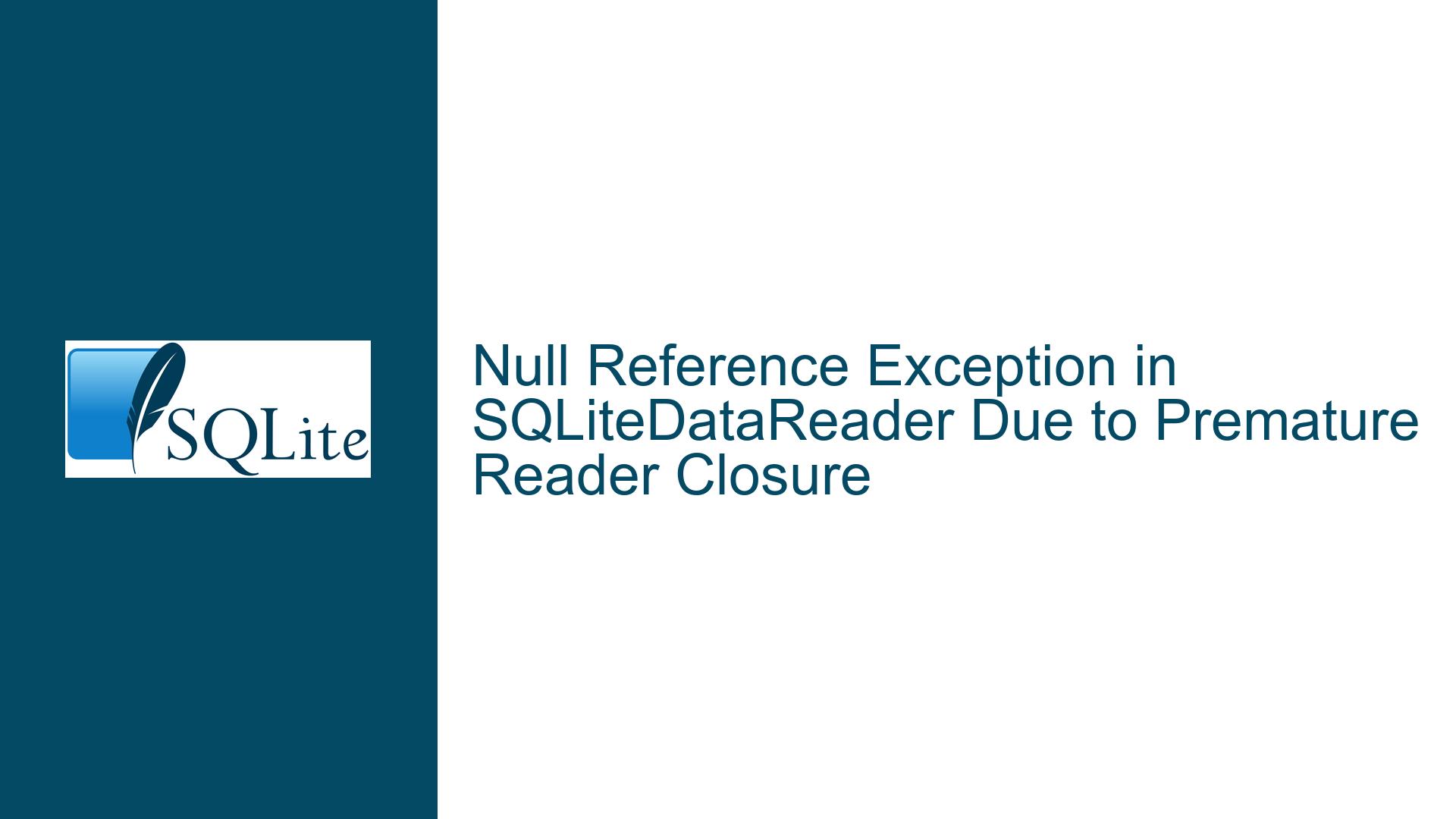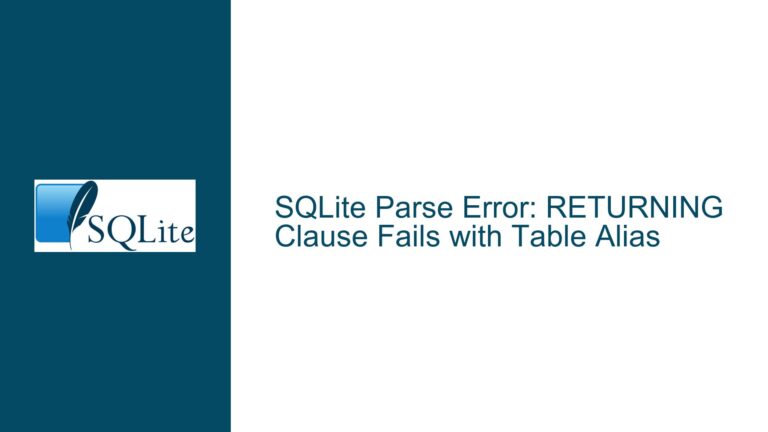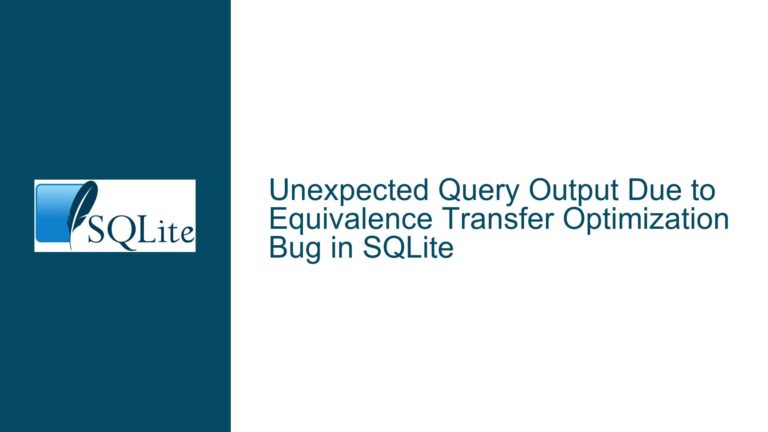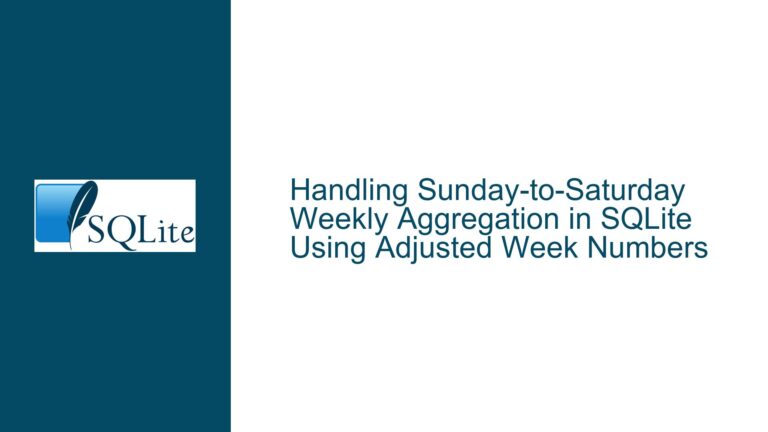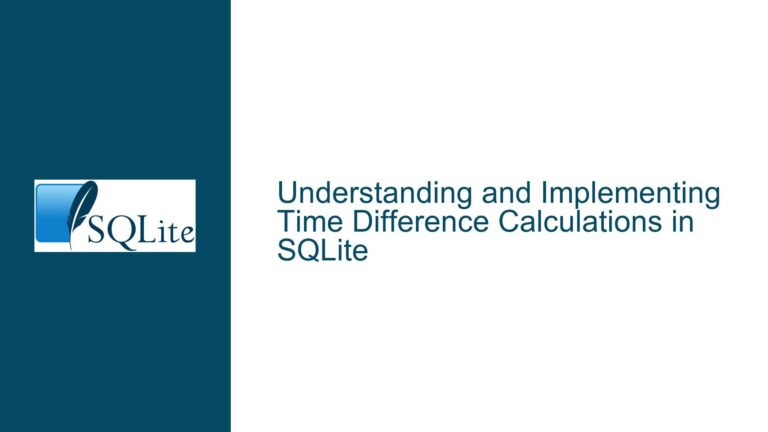Null Reference Exception in SQLiteDataReader Due to Premature Reader Closure
Issue Overview: Null Reference Exception in SQLiteDataReader
The core issue revolves around a System.NullReferenceException being thrown within the System.Data.SQLite.SQLiteDataReader.Step method. This exception occurs intermittently across multiple devices when executing a SQL query to read data from a table named Update_Ticket. The query itself is straightforward: SELECT * FROM Update_Ticket;. The exception is not consistently reproducible, making it particularly challenging to diagnose. The stack trace indicates that the error originates deep within the SQLite library, specifically during the execution of the Step method, which is called internally by the Read method of the SQLiteDataReader.
The SQLiteDataReader is used to iterate over the results of the query. The code structure is as follows:
sql = "SELECT * FROM Update_Ticket";
SQLiteDataReader reader = this.localDataService.ExecuteReader(sql);
while (reader.Read())
{
// Process the data
}
The exception occurs at the while (reader.Read()) line, but only sporadically. The table Update_Ticket is often empty, but this does not consistently trigger the exception. The issue is further complicated by the fact that the same pattern of code is used in over 100 other places in the application without issue. This suggests that the problem is not with the general pattern of reading from the database but rather with something specific to this particular query or its execution context.
Possible Causes: Premature Closure of SQLiteDataReader
After a thorough analysis of the code and the context in which the exception occurs, the most plausible cause of the NullReferenceException is the premature closure of the SQLiteDataReader object. This premature closure can occur if the reader.Close() and reader.Dispose() methods are called inside the while loop, which is exactly what was happening in this case. The code was structured as follows:
sql = "SELECT * FROM Update_Ticket";
SQLiteDataReader reader = this.localDataService.ExecuteReader(sql);
while (reader.Read())
{
// Process the data
reader.Close();
reader.Dispose();
}
In this scenario, the reader.Close() and reader.Dispose() methods are called after processing the first row of data. If there is only one row in the Update_Ticket table (which is often the case), the reader object is closed and disposed of before the next iteration of the while loop. When the while loop attempts to call reader.Read() again, the reader object is already closed, leading to a NullReferenceException within the internal Step method of the SQLiteDataReader.
This issue is particularly insidious because it does not manifest consistently. If the Update_Ticket table contains multiple rows, the while loop may complete without issue. However, if the table contains only one row, the premature closure of the reader object will cause the exception to be thrown on the next iteration of the loop. This explains why the issue is sporadic and difficult to reproduce.
Troubleshooting Steps, Solutions & Fixes: Proper Management of SQLiteDataReader Resources
To resolve this issue, it is essential to ensure that the SQLiteDataReader object is properly managed and not prematurely closed or disposed of. The reader.Close() and reader.Dispose() methods should be called only after the while loop has completed its iteration over all rows in the result set. The corrected code should look like this:
sql = "SELECT * FROM Update_Ticket";
SQLiteDataReader reader = this.localDataService.ExecuteReader(sql);
while (reader.Read())
{
// Process the data
}
reader.Close();
reader.Dispose();
Alternatively, the using statement can be used to ensure that the SQLiteDataReader object is automatically disposed of when it goes out of scope. This approach is generally preferred as it reduces the risk of resource leaks and ensures that the reader object is properly disposed of even if an exception occurs. The code using the using statement would look like this:
sql = "SELECT * FROM Update_Ticket";
using (SQLiteDataReader reader = this.localDataService.ExecuteReader(sql))
{
while (reader.Read())
{
// Process the data
}
}
In this version of the code, the SQLiteDataReader object is automatically disposed of when the using block is exited, eliminating the need for explicit calls to reader.Close() and reader.Dispose().
Additional Considerations
Database Connection Management: Ensure that the database connection is properly managed. If the connection is opened at the start of the application and reused throughout its lifecycle, make sure that it is not being closed or disposed of prematurely. If a new connection is opened for each query, ensure that it is properly closed after the query is executed.
Thread Safety: If the application is multi-threaded, ensure that access to the database connection and
SQLiteDataReaderobjects is properly synchronized. Use mutexes or other synchronization mechanisms to prevent multiple threads from accessing the same database resources simultaneously.Error Handling: Implement robust error handling to catch and log any exceptions that occur during database operations. This will help in diagnosing issues that may arise in production environments.
Database Integrity: Although the issue in this case was not related to database integrity, it is always a good practice to periodically check the integrity of the database using the
PRAGMA integrity_checkcommand. This can help identify and resolve any underlying issues that may affect the stability of the database.Code Reviews and Standards: Enforce strict code review processes and coding standards to prevent similar issues from occurring in the future. Ensure that all developers adhere to best practices for managing database resources and handling exceptions.
By following these steps and ensuring that the SQLiteDataReader object is properly managed, the NullReferenceException issue can be effectively resolved, leading to more stable and reliable database operations in the application.
